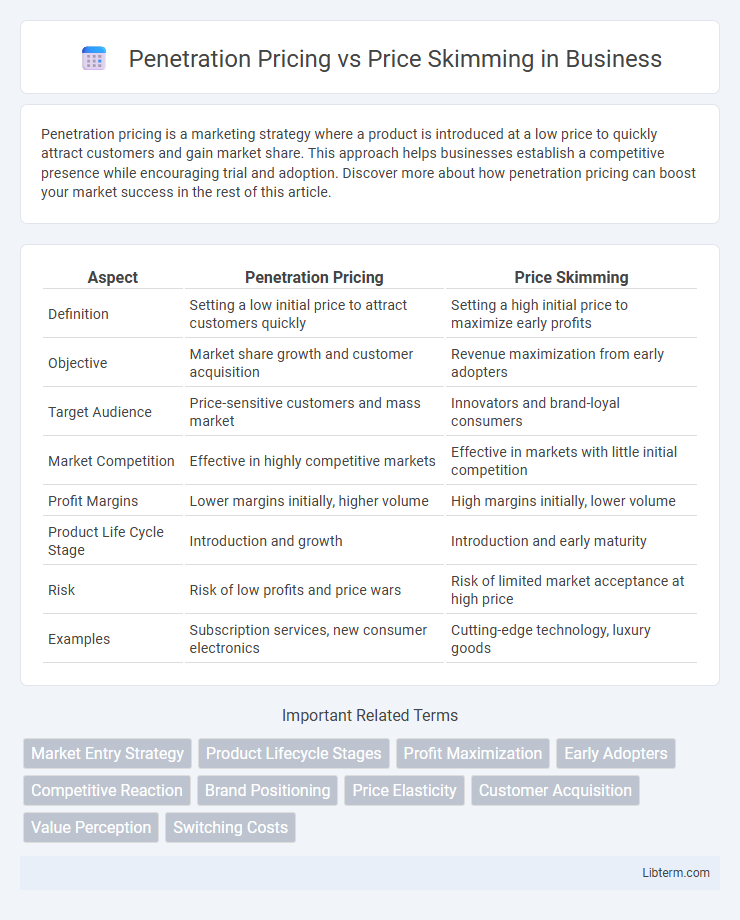Penetration pricing is a marketing strategy where a product is introduced at a low price to quickly attract customers and gain market share. This approach helps businesses establish a competitive presence while encouraging trial and adoption. Discover more about how penetration pricing can boost your market success in the rest of this article.
Table of Comparison
| Aspect | Penetration Pricing | Price Skimming |
|---|---|---|
| Definition | Setting a low initial price to attract customers quickly | Setting a high initial price to maximize early profits |
| Objective | Market share growth and customer acquisition | Revenue maximization from early adopters |
| Target Audience | Price-sensitive customers and mass market | Innovators and brand-loyal consumers |
| Market Competition | Effective in highly competitive markets | Effective in markets with little initial competition |
| Profit Margins | Lower margins initially, higher volume | High margins initially, lower volume |
| Product Life Cycle Stage | Introduction and growth | Introduction and early maturity |
| Risk | Risk of low profits and price wars | Risk of limited market acceptance at high price |
| Examples | Subscription services, new consumer electronics | Cutting-edge technology, luxury goods |
Understanding Penetration Pricing
Penetration pricing involves setting a low initial price to quickly attract customers and gain market share, often used in highly competitive markets or for new product launches. This strategy emphasizes volume sales over high profit margins, aiming to create customer loyalty and deter competitors. Effective penetration pricing requires careful cost analysis to ensure sustainability while driving rapid adoption.
What is Price Skimming?
Price skimming is a pricing strategy where a company sets a high initial price for a new or innovative product to maximize profits from early adopters willing to pay a premium. This approach targets market segments with less price sensitivity and gradually lowers the price over time to attract more price-conscious customers. Price skimming helps recover research and development costs quickly and positions the product as premium in competitive markets.
Key Differences Between Penetration Pricing and Price Skimming
Penetration pricing involves setting a low initial price to quickly attract a large customer base and gain market share, while price skimming sets a high initial price to maximize profits from early adopters before gradually lowering it. Penetration pricing sacrifices short-term profits for rapid market entry and volume, whereas price skimming targets maximum revenue from segments willing to pay premium prices first. The strategy choice depends on market competition, product lifecycle, and consumer demand elasticity.
Advantages of Penetration Pricing
Penetration pricing offers rapid market entry by setting low initial prices to attract a large customer base and achieve high sales volume quickly. This strategy enhances brand awareness and deters competitors by creating strong market presence early on. It also facilitates economies of scale, leading to cost advantages as production expands.
Benefits of Price Skimming
Price skimming allows companies to maximize early profits by targeting consumers willing to pay a premium before gradually lowering prices to capture more price-sensitive segments. This strategy helps recover research and development costs quickly and establishes a high-quality brand perception. Leveraging initial high margins supports funding for marketing and product improvements, driving long-term competitive advantage.
Situations Favoring Penetration Pricing
Penetration pricing is most effective in highly competitive markets where gaining rapid market share is crucial and customers are price-sensitive. This strategy suits products with a broad target audience, allowing companies to attract price-conscious buyers quickly and discourage rivals from entering the market. Businesses often implement penetration pricing when product demand is elastic, enabling volume sales to offset lower profit margins and establish strong brand loyalty early on.
When to Use Price Skimming
Price skimming is most effective when launching innovative or high-demand products with limited competition, allowing businesses to maximize profits from early adopters willing to pay premium prices. This strategy suits markets with inelastic demand and strong brand loyalty, where initial high prices can be gradually reduced to attract more price-sensitive customers over time. Companies should use price skimming to recover research and development costs quickly while maintaining product prestige and market exclusivity.
Potential Risks and Drawbacks
Penetration pricing risks include low initial profit margins and the challenge of raising prices later, which may alienate price-sensitive customers. Price skimming carries the drawback of deterring price-sensitive buyers early, potentially limiting market penetration and inviting competitors to undercut prices. Both strategies risk damaging brand perception if pricing changes are mismanaged or perceived as inconsistent.
Industry Examples of Both Strategies
Penetration pricing is exemplified by Netflix, which initially offered low subscription fees to rapidly gain market share in the streaming industry. Price skimming is demonstrated by Apple, which sets high launch prices for new iPhone models to maximize revenue from early adopters before gradually reducing prices. Both strategies leverage distinct market dynamics to optimize profitability and competitive positioning across technology and entertainment sectors.
Choosing the Right Strategy for Your Business
Choosing between penetration pricing and price skimming depends on market conditions and business objectives. Penetration pricing involves setting a low initial price to quickly attract customers and gain market share, ideal for highly competitive markets or products with high price elasticity. Price skimming sets a high initial price to maximize profits from early adopters before gradually lowering prices, suited for innovative or unique products with less price sensitivity.
Penetration Pricing Infographic

 libterm.com
libterm.com